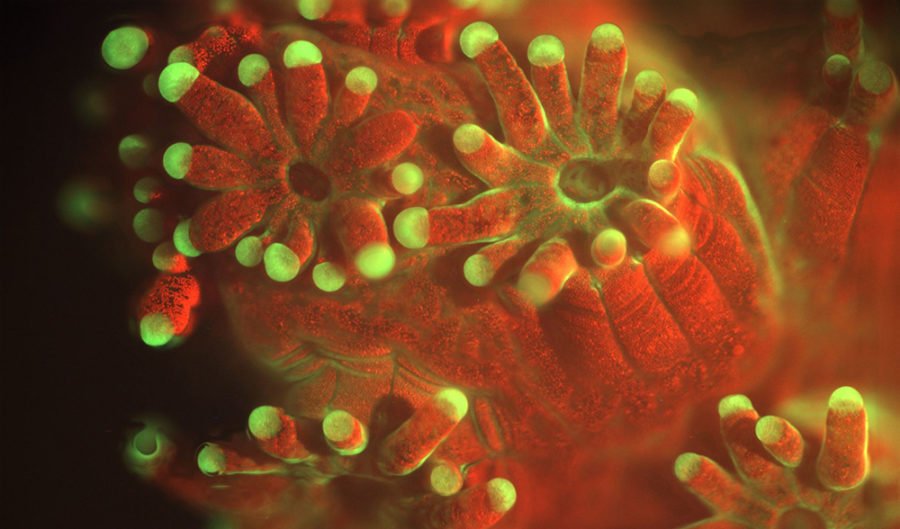VIDEO: Dancing and kissing corals

UNDER THE SEA, life is rich and diverse but when it comes to the tiny organisms living under the waves, the details of their daily affairs remain hard to study.
Now, researchers say the secret life of tiny marine organisms such as corals and algae can be revealed thanks to a new, specialised underwater microscope that can record high-quality images and videos at unprecedented resolution.
“What is really special about this instrument is that you can take it into the underwater environment and use it to record microscopic images and video of marine animals right in their natural setting,” said Andrew Mullen, a doctoral student and oceanographer at the Scripps Institution of Oceanography in California, USA.
The new micsroscope, developed by Andrew with Dr. Tali Treibitz, Dr Jules Jaffe and Dr Paul Roberts, is described in a new study published today in the journal Nature Communications.

In situ image acquired using the 3x objective lens, in Eilat, Israel. The image is an enhanced depth-of-field composite formed from a focal scan z-stack. The field of view is 1.7mm x 1.4mm.(Image: Andrew Mullen)
Completely replicating the wild marine environment in the lab is impossible, due to the complex and ever-changing nature of the ocean, explained Andrew.
“It is important to be able to observe marine organisms in the ocean because their natural environment is influenced by so many parameters that we may not be able to faithfully recreate in the lab such as variations in temperature, pH, oxygen and the ever-drifting flux of water, not to mention the countless interaction that occurs between different organisms,” he said.
And taking your camera underwater to track down tiny organisms is not easy. The technology developed so far has been focused on large-scale processes, but there is a lack of instruments for recording the life of small organisms.

Pocillopora coral under fluorescent illumination. Fluorescent image of the coral Pocillopora damicornis recorded in the lab. Field of view is 4.2mm x 3.5mm. (Image: Andrew Mullen)
The new underwater microscope is the first to produce near-micrometre resolution – that’s a thousand times smaller than a millimetre – thanks to a combination of new, cutting-edge technologies. “We use a specialised microscope lens that looks at subjects several centimetres away, so that we can image through an underwater port. Also, we focus the system using a lens that changes its shape, similar to how your eye works,” said Andrew, who, along with his team, worked for one and half years to complete the microscope.
To test the capabilities of the new microscope, Andrew explored the life of corals from the Gulf of Eilat, in the Red Sea. One of the results obtained from these observations revealed a previously unknown behaviour between coral polyps (the tiny soft-bodied organism that form coral reefs), which researchers have dubbed ‘polyp kissing’. “Here, neighbouring polyps periodically embrace each other throughout the night, possibly to share organic materials,” he explained.

Microscope deployment. (Image: Emily L. A. Kelly)
The team was also able to record the behaviour of different species of coral colonies placed in close proximity. Their recordings revealed unprecedented details on the attacking behavior and competitive behavior of different species of coral. “This competitive behaviour included corals emitting mesenterial filaments, an extension of their gut, in order to digest neighbouring competing coral colonies,” Andrew said.
Andrew hopes the new invention will be useful for other researchers to explore the oceans, while he plans to work on enhancing the system by incorporating further capabilities, such as the ability to measure small-scale water motions around marine organisms.
Dr James Falter, a marine scientist at the University of Western Australia who wasn’t involved in the development of the new underwater microscope, said the technology had great potential in his field of expertise.
“The best aspects of this technology is that it is both portable and non-invasive,” he said. “It will allow us to discover new behaviours and interactions between marine life that would have otherwise remained hidden from the naked eye’
RELATED:
- New microscope technology possible game-changer
- Secrets of the Coral Sea revealed
- Coral spawning: a natural wonder

